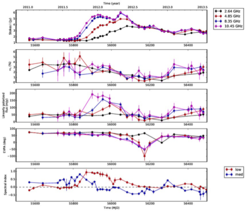Ioannis Myserlis
PhD Project: Extragalactic relativistic jet microphysics through Linear and Circular multi-frequency polarization monitoring

Ioannis Myserlis
© I. Myserlis (MPIfR)

Polarization parameters of the blazar PKS 1510−089, as obtained with the F-GAMMA program. From top to bottom: Stokes I, Linear polarization degree ml, polarized flux, EVPA and spectral index in two radio bands (α2.6-8.4 GHz and α10.5-23.1 GHz). The source shows the characteristics of the constructed “toy” model: the optical depth evolution around MJD 56180, reflected on the spectral index evolution, is accompanied by polarization degree minimization and two consecutive EVPA rotations of 90 degrees. This is exactly the behavior as predicted by Synchrotron theory
© I. Myserlis (MPIfR)

